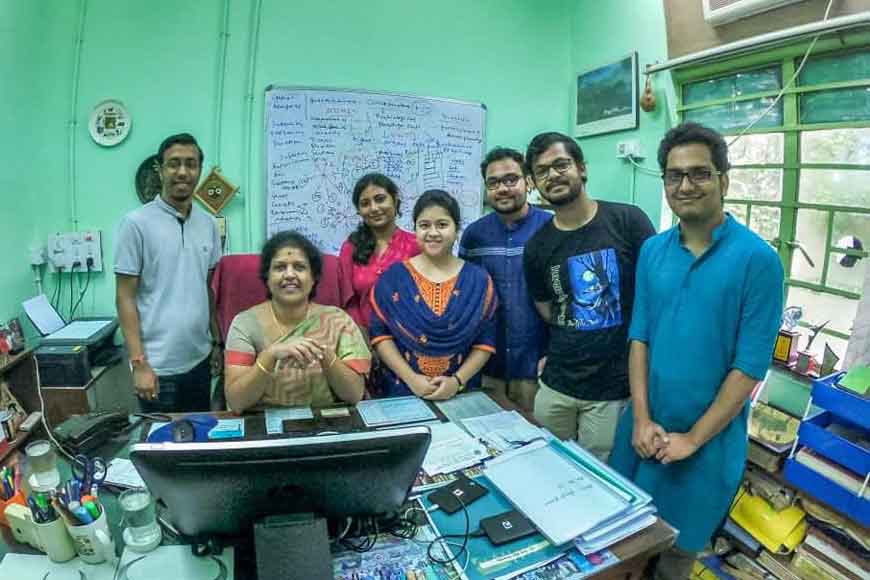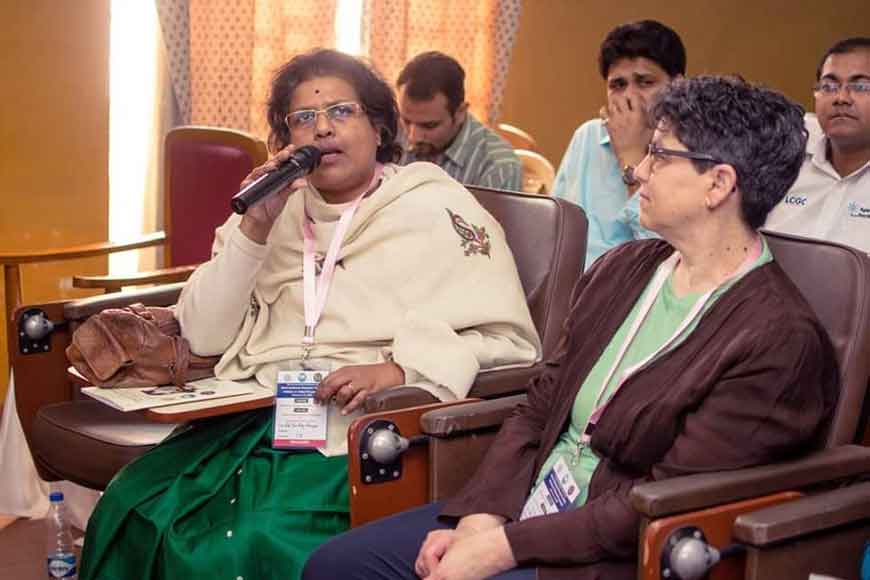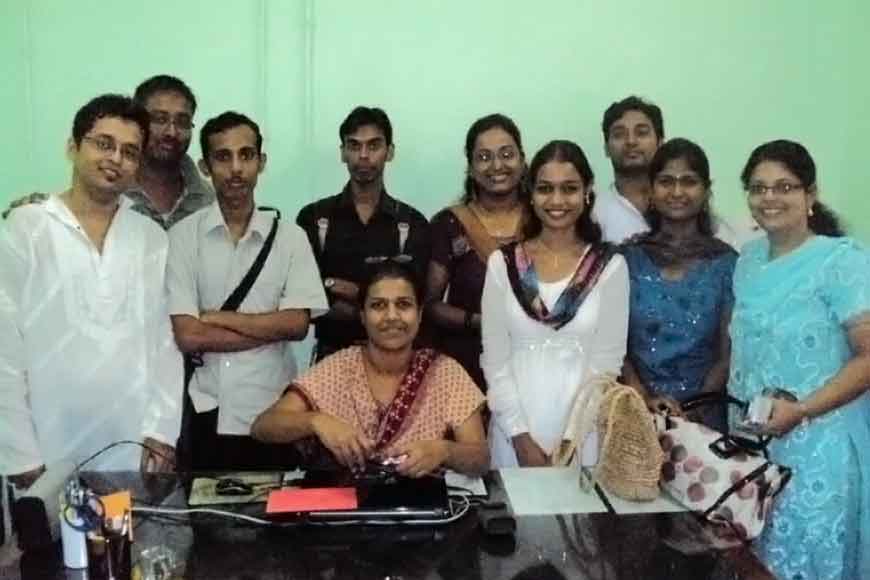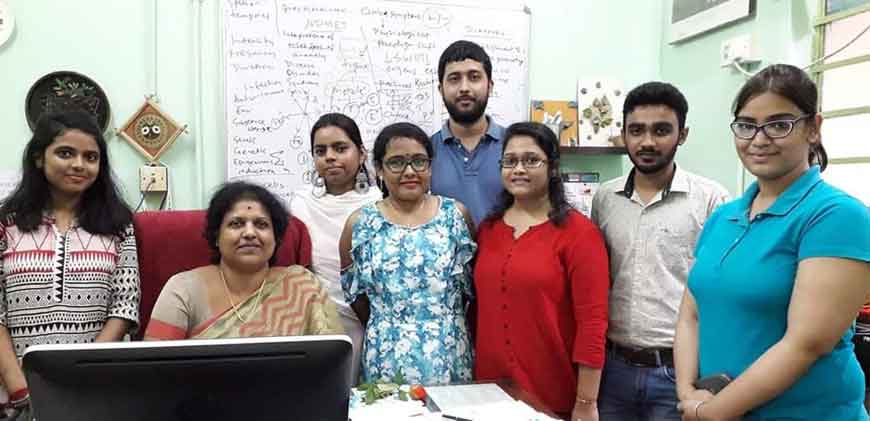Prof Ena Ray Banerjee says diverse gene pool of Indians can help fight COVID-19 better

An exclusive interview with Professor Ena Ray Banerjee, PhD, DSc, Professor Dept of Zoology University of Calcutta Immunology and Regenerative Medicine Research Unit. From how the COVID virus mutates, to how Indians can fight the COVID-19 better, Prof Banerjee gives an in-depth scientific view of the pandemic
• What happens after Lockdown is lifted? Even if COVID-19 cases are controlled by social distancing, the Virus will still remain. Will it keep infecting for ages just like other viruses do?
SARS COV 2 is a positive sense single stranded RNA virus. Like all of its ilk, it is known for rapid mutation because of its inherently unstable structure. As data shows, it has already mutated several times but it is not likely to mutate and become suddenly non-virulent. Nor is it going away anywhere. It may however, progressively calm down in its contagious powers as it tries to attain a more stable form.
The lockdown, I believe, was implemented to keep the numbers down so as not to overwhelm the medical system and unduly clog the available resources. Out of 2400000 positive cases worldwide, 165000 deaths have been reported that shows about 6.4% killing rate of the virus, most of which is also reported to be along with co-morbidities of hypertension, diabetes, cardiovascular disease, asthma etc. The old are also purported to be more susceptible to the virus and likely to succumb to it. The contagion spreads by contact and inhaled as aerosols. Thus, physical distancing in a social set up is key to slow down community spread.
• What is your take on COVID-19 virus’ lethal power and has Lockdown helped to flatten the curve?
Interestingly, a parasite ideally does not wish to kill its host. A virus being an accidental nugget of genetic code, also wants to program itself such that it leaves indelible copies of its blue print in a form of life that will permit it to do so. Unfortunately for us, it found the perfect combination in our angiotensin converting enzyme 2 and a set of perfectly co-ordinated proteases to jump-start its replicons and usurp our transcriptome to procreate, thereby kicking up a severe cytokine storm that compromises us and perhaps kills us. It is all quite unintended and accidental really. The stealth and swiftness and sure-footedness has so far worked in its favor as our immune system has not quite figured out how to tackle it.
The lockdown has bought us time for:
a) Infected immune systems of strong and young humans to figure it out (active immunity by infection).
b) Scientists to study and figure out small molecules, RNA interference, decoy receptors, or synthesized antibodies that will stop any or all of the processes that has rendered this creature almost invincible so far.
c) Convalescent plasma of survivors that provide adaptive protection to recipients (passive immunity), any of a-c will act as a shield forbidding its virulence and stopping the contagion in its tracks.
d) A vaccine to pre-empt an infection
e) Making our collective protection against its sojourn through our species making it virtually ineffective (herd immunity).
But when lockdown is lifted, how can the human race protect itself when a large number of its members have been quickly infected and a sizeable fraction has succumbed to the infection. The much-touted ‘flattening of the curve,’ to my mind, is misleading.
None of the aforementioned a-e has yet happened to any great extent, except perhaps ‘a’ to a small extent but then news of a repeat infection from South Korea and China is worrisome. Anyway, to hide indefinitely from an incumbent infection in the long term is unavoidable. So the moment the lockdown is lifted, no matter how well ‘social distancing’ is practised, the viral configuration remaining unchanged, there is bound to be a flare up. In that case, either a-d or if not till then, e remains our only option. We have to segregate the vulnerable, control morbidity and mortality using whatever arms are available in our arsenal by then and some of us will have to get infected to build up the herd immunity.

• Will BCG vaccination and our exposure to pathogens help Indians in their immune response?
Some publications have speculated that protection against one pathogen such as TB (via universal BCG vaccination) or Malaria and other microbes is likely to render the Indian population slightly more equipped with a larger repertoire of HLA (type immunity) accidentally protecting us against the new pathogen. The rapid mutation of SARS COV 2 in the Indian population has also shown that it has developed a good fit for the human micro RNA 27b, that activates a potent immune attack machinery and will also likely fight for us. The huge microbial load, by Gause’s Principle of ecological competition and exclusion may also (surprisingly) give the newcomer a good fight on our behalf (because it likes to feast on our lung and is averse to share its loot with the newcomer).
Many recent reports through ICMR’s testing have revealed that many of the SARS COV 2 positive are asymptomatic. If a SARS COV 2 positive (by the presence of viral antigen or antibody generated against it, that is not clear from these reports) person does not fall violently sick after the incubation period, then that gives me hope that perhaps we are already building up herd immunity, that is, a large number of Indians are able to withstand the infection without major damage, or that the viral serotype may be losing virulence. So, life after lockdown has to be slow and cautious, the vulnerable have to be protected, and the infection may be allowed to progress in the more resistant group and the intensity of the pandemic may die out through this process.
• How far will a vaccine really help? Flu vaccine is usually effective for one year only and a regular shot is needed. Even then people keep dying every year
Flu vaccines often do not work as influenza and other related seasonal viruses, namely rhinoviruses, coronaviruses etc., frequently change their form. We fall sick during flu season and recover. It is possible that SARS COV 2 may also behave similarly or we may become immune to it by then and instead of the severe form of the disease, only milder episodes play out in the human host. Worldwide statistics show its current killing power at 6-8% but a much higher Reproductive Number. This may flip as is common with epidemics and pandemics in line with the classic Red Queen hypothesis of ecology. Species with a host and parasite relationship constantly fight this evolutionary arms race with each other and both our genomic codes keep adjusting. Neither wins, neither loses.
• Many scientists in the West say mass infection and mass deaths as seen in USA and Europe will help in natural mass immunity where a large portion of the population will have an antibody against COVID 19. Then should the Indian population be also exposed and allowed to resist the virus by herd immunity?
As I said before, yes. India’s natural racial heterogeneity, our huge variety of HLA repertoire, our microbial load and diverse immune memory and our culture (food habits and social practices) may work in our favour. We, Indians, are a 1.36 billion strong young community of multi-racial origin. If any race can dare to face the onslaught head on, it is us. So yes. Even though a large section of our people are malnourished and there is relatively high early childhood mortality in many areas, even though our people face a larger variety of tropical and sub-tropical diseases, perhaps more than many other countries, even though practically social distancing is impossible in our slums and villages, we have seen that past contagions have eventually died out.
In 1898, the Bombay plague or the bubonic plague ravaged India where 22 people with the disease died out of every 1000 infected while 12 deaths happened due to TB and 14 out of 1000 died due to cholera ; in 1918, the Spanish flu pandemic killed about 5% of the population; in 1978 the small pox epidemic killed and maimed a large no. of people but by 1980, pulse vaccination program eradicated the disease completely; in 2009 the swine flu epidemic hit India and there was widespread panic but within 4 months it died down; the list goes on. There is no new case reported of these aforementioned diseases in a large scale ever since. So historically, these large outbreaks seem to be either auto-regulating both their contagion (spread) or virulence (disease) or the population becomes resistant.
• Several viruses come and go, yet COVID 19 has turned into a nightmare. Is it because it is highly transmissible or very virulent?
Both. It is highly transmissible. The reproductive number – the number of secondary infections generated from one infected individual – is estimated to be between 2 and 2.5 for COVID-19 virus, higher than for flu. The clinical range of symptoms for this and other respiratory viruses is similar, but the fraction with severe disease appears to be different and the extent of lung damage is more insidious and long drawn out, the initial onslaught being much more intense than any other known to us. The airway septal damage by COVID 19 within a week is equivalent to severe and chronic asthma or emphysema induced degeneration playing out over years.
This, coupled with a severe cytokine storm like in a full blown auto-immune disease further immunocompromises the infected person (rendering it ineffective against the pathogen) while its own immune machinery turns on itself and damages the tissue. Thus this disease is much more destructive within a short time span and much more infective with transmissibility and range of transmission being quite extraordinarily swift. For COVID-19, data to date suggest that 80% of infections are mild or asymptomatic, 15% are severe infection requiring oxygen and 5% are critical infections, requiring ventilation. These fractions of severe and critical infection are several degrees higher than what is observed for influenza infection. This is what makes it a nightmare.
Curiously and terrifyingly, this virus kicks up a chain reaction arousing the immune faculties of the body to a hysterical pitch. A dangerous, newly observed tendency to blood clotting may potentially transform mild cases into life-threatening emergencies. An overzealous immune response escalates clinical complications. Despite startlingly low blood oxygen in patients they do not gasp for breath. Thus even though the lung tissue is ground zero, the malaise quickly spreads and affects other organs, often like never before leaving the healthcare professionals baffled.

• Reports show COVID 19 has a part of HIV virus strain and also a part of malarial parasite. Does this indicate it is a lab made virus?
Not exactly. SAR COV2 does not contain part of HIV genome per se as shown by nucleotide sequence analyses and overlap. SARS COV 2 is a coronavirus and shares 79% similarity with its predecessor SARS COV. It also shares similarities with HIV, which is a retrovirus with a glycoprotein coat, justifying the similarity. It shares part of its genome with HKU1-COV, causative agent of mild pneumonia, with human coronavirus NL6, with human metapneumovirus SARS, as it does with others such as the 229E and OC43 human coronaviruses affecting human respiratory tract. SARS COV 2 has sequences matching the betacoronaviruses of bat and pangolins too. Human SARS COV virus causing the epidemic in 2009 showed similarities with coronavirus of Himalayan palm civets, suggesting that silent sylvatic pools (animal reservoirs) may exist before it evolves through random mutations in its open reading frames and may make the final species jump. SARS COV also shared genomic similarities with human metapneumovirus, Chlamydia pneumoniae, Mycoplasma and Legionella app. It also has genomic similarities with Chlororchis sinensis and Plasmodium falciparum. We all have originated from a common ancestor and some degree of homology (gene and protein sharing) is found in all living organisms. The way it differs from its closest relative SARS COV is in its spike protein that binds with the receptor protein ACE 2 in the human host cells. With coordinates based on SARS-CoV, the amino acids that differ are: Y442, L472, N479, D480, T487 and Y4911, corresponding to L455, F486, Q493, S494, N501 and Y505 in SARS-CoV-2 as elucidated in a publication by the journal Nature Medicine. Even if we concede that some scientist in China was actually meticulously using reverse genetics to substitute amino acids via nucleotide codons through trial and error of best binding efficiency possible between the virus's chosen portal of entry in the human host, this will take years of work and are more likely to go wrong in an RNA model of the base virus that a plausible bio weapons researcher may be purported to have chosen. No it seems more of a chance through frequent natural selection and possibly due to dense proximity with bats and pangolins to humans.
• Many are saying HCQS is working against COVID. What is your take on it?
HCQ is a lysosomotropic drug. It acts by raising the pH of lysosomes that house the malarial parasite within host cells thus pre-empting its basic biology and preventing its replication to the next stage. HCQ may prevent, in a similar manner, the SARS COV 2 from releasing its proteases that break down its pro-protein into smaller units with designated functions that would have worked in an assembly line fashion to hijack the host transcriptome (via its ribosomes present in the infected cell).
In other words, Chloroquine and its hydroxy derivative being lysosomotropic agents, may prevent endosomal acidification. Taking cue from dengue virus such endosomal acidification is needed for viral RNA to be released. HCQ may be preventing release of corona RNA inside host cells through somewhat similar mechanisms. Another drug, for example, azithromycin is also known to play some role in internal mobilization of lipid inside cell which also may be needed for virus assembly. This is apart from its known ability to clear secondary bacterial infections and helping well in COPD like symptoms, through its anti-inflammatory role, which patients suffer once they get viral pneumonia.
• How much does climate change and global warming play a role in bringing about new viruses?
A direct answer to this will be at best speculative really. The closest I am willing to opinionate on the issue of global warming is that whenever there are large quanta of shifts in environmental parameters, evolution gets warped, both at micro and macro levels. In other words, there is large scale jostling for space in terms of resource utilization, ease and efficiency of procreation and safety from hostile forces. Whichever species can manage well with this sudden paradigm shift, has an evolutionary advantage. The positive natural selection pressure obviously works in its favor. Human activity is the biggest factor for such large shifts in terms of not only climate but also distribution and interaction with flora and fauna which are in close proximity to humans. Thus, yes, humans may quite possibly contribute to the spawning of new viruses just as melting of the permafrost and shifting of the snow line may resurrect old and forgotten ones.
• What kind of work do you think scientists in Kolkata can take up to beat the virus? What is the need of the hour?
I believe systematic study on the following should be conducted without delay to conquer the COVID 19 pandemic:
(i) Sequencing of genetic variants in Indian populace tracing back to the original carrier from another country. From travel history, the source strain of SARS COV 2 can be found and from there degree of genetic devastation may be found too. This will enable predictive extrapolation of viral genetic shifts.
(ii) Different serotypes in the affected people need to be studied. Imported ELISA based kits may not work if the Indian serotypes are significantly different.
(iii) Assembly line testing requires centrally co-ordinated recruitment of labs from whoever volunteers (with appropriate skill, facility, willingness)- national labs, state & central universities, private companies et al. with contingent plans to provide additional training / facility and scale up. This will help test and trace efficiently but first to develop robust kits requires basic research on points i and ii. I understand that DBT via its NIBMG has initiated some testing in Kalyani.
(iv) Central data management of findings from around the country and world on SAR COV2 needs to be collated and put on easily accessible portals that scientists may refer.

• Do you and your students plan to take forward any viral study or use stem cell / plasma therapy studies to find a cure?
Functional food validated through our discovery research has found anti-infectives that are in the pipeline for anti-COVID19 therapy including extracts of Paan (Piper betle) and Khejur (Phoenix sylvestris) that contain flavonoids and phenolic compounds. We are also working on molecular diagnostics of SARS COV 2 by novel design of primer of two conserved sequences of its nucleocapsid protein. We are also planning to use our novel camelid nano antibody technology platform to generate specific antibodies for detection and therapy of viral particles. But unfortunately, these require lengthy approvals and clearances from the authorities. Meanwhile since we are principally a lung lab, our previous research on lung regeneration and control of lung inflammation may come in handy for post-COVID19 damaged lung repair and controlling the cytokine storm that is a hallmark of this infection.
• As a scientist pls tell us how to brace this virus, should we take it like any other virus and leave it to Darwin's evolution theory of Survival of the Fittest?
We need to lead a balanced life. We usually do not. We need to strengthen our immune system by consuming seasonal and local unadulterated food. We need to have good cultural habits and practices. Much of the Hindu way of life promulgated such habits and practices but much of this got lost over time. By Hindu, I do not allude to the religious connotation, but more the philosophy of the Hindu way of life and its associative good practices. Many such practices as well as Yoga and Ayurveda (traditional medicine) are being reiterated in COVID 19 prevention. Most of us do not have good knowledge of what exactly comprises the aforementioned (including myself) leading to a loss of balance with the natural way of life leading to a number of diseases that has anyway bugged us even before COVID 19 appeared on the horizon. Basic science research must be encouraged with concomitant translation for application. With the gradual lifting of lockdown, armed with appropriate therapy to slow down the virus, plasma derived therapy with convalescent plasma of recovered people, our immense immune arsenals that is a gift of India's diversity, and the immense power of human resilience, we shall tide over the crisis as we have done in the past. Yes, there will be collateral damage, yes, many of us may perish in the process, but we shall be all the richer for the knowledge gained and may be relinquish the habits that make us not-so-human anymore.










